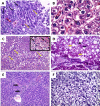The Apoptotic Effect of Trichinella spiralis Infection Against Experimentally Induced Hepatocellular Carcinoma
- PMID: 33773560
- PMCID: PMC8286675
- DOI: 10.31557/APJCP.2021.22.3.935
The Apoptotic Effect of Trichinella spiralis Infection Against Experimentally Induced Hepatocellular Carcinoma
Abstract
Background: Hepatocellular carcinoma (HCC) is the sixth most common type of cancer. Prognosis of HCC remains unsatisfactory. Therefore, developing new therapeutic modalities is still mandatory. Tumor biotherapy is a novel concept developed as a therapeutic strategy for cancer treatment. There is a similarity between the regulatory mechanism of Trichinella spiralis nurse cell formation and tumor cell apoptosis signal regulation.
Objectives: Induction of apoptosis by T. spiralis can represent a new strategy for tumor treatment.
Methods: Experimental animals were divided in four groups; negative control (GI), T. spiralis infected (GII), induced HCC (GIII) and HCC then infected with T. spiralis (GIV). The apoptotic effect of T. spiralis infection was assessed by histopathological and immunohistochemical staining of B-cell lymphoma 2 (Bcl-2).
Results: We found higher survival rate of rats and decreased weight of their livers with no nodules in HCC- T. spiralis group as compared to HCC group. Improvement of the dysplastic changes and increased apoptotic bodies which was confirmed by decreased expression of Bcl-2 reported in HCC- T. spiralis group.
Conclusion: Trichinella-induced apoptosis can be a contributing mechanism of the anti-tumor effect of T. spiralis infection. Our results showed a certain level of decreased progression of the tumor in HCC-T. spiralis group as indicated by increased rate of apoptosis and subsequently had a positive impact on the survival of rats.<br />.
Keywords: Apoptosis; Bcl-2; Hepatocellular carcinoma; Trichinella spiralis.
Conflict of interest statement
The authors declare that they have no conflict of interest.
Figures








References
-
- Alenzi FQ, El-Nashar EM, Al-Ghamdi SS, et al. Investigation of Bcl-2 and PCNA in hepatocellular carcinoma: Relation to Chronic HCV. J Egypt Natl Canc Inst. 2010;22:87–94. - PubMed
-
- Babal P, Milcheva R, Petkova S, Janega P, Hurnikova Z. Apoptosis as the adaptation mechanism in survival of Trichinella spiralis in the host. Parasitol Res. 2011;109:997–1002. - PubMed
-
- Badr El-Din NK, Ali DA, Othman R, et al. Chemopreventive role of arabinoxylan rice bran, MGN-3/Biobran, on liver carcinogenesis in rats. Biomed Pharmacother. 2020;126:110064. - PubMed
-
- Boonmars T, Wu Z, Nagano I, et al. Expression of apoptosis-related factors in muscle infected with Trichinella spiralis. Parasitology. 2004;128:323–32. - PubMed
MeSH terms
LinkOut - more resources
Full Text Sources
Other Literature Sources

